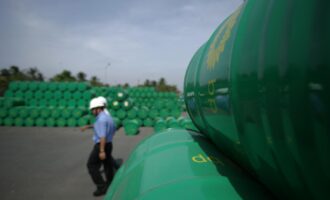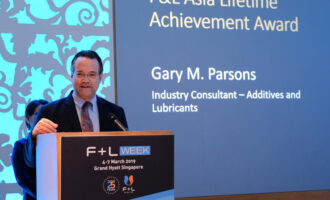The Truth about Chlorinated Paraffins
By Cristine Villena Amurao, M.D., M.P.H.
The usefulness of chlorinated paraffins (CPs) as an extreme pressure additive in metalworking and in a vast number of other applications for over 80 years is undisputed. But why is there renewed interest in CPs worldwide? It is easier to understand why, when several simple questions are answered.
What do we really know about chlorinated paraffins?
Chlorinated paraffins, also known as polychlorinated n-alkanes, are basically divided into four classes, with a push towards distinguishing a fifth. The most well-known and well studied are the short chain CPs (SCCPs) with 10 to 13 carbons, then medium chain CPs (MCCPs) with 14 to 17 carbons, long chain CPs with 18 to 20 carbons and lastly, the new kid on the block: very long chain CPs (vLCCPs) with 21 or more carbon molecules. The carbon chain length and degree of chlorination of CPs play an important role in distinguishing different CPs’ properties that affect their uses as well as their impact on people and the environment.
Where can you find them?
CPs are practically found everywhere. From the Artic to the Antarctic, from East Asia to North America and from Europe to Australia. They are almost literally in everything as well. Studies have isolated them in air (atmospheric and indoor), water (aquatic environment, rivers, lakes and oceans), dust, sediment, soil and wastewater treatment sludge/sewage sludge. Dated sediment core samples representing 120 years have shown that increased levels of CPs in sediment during the 1980s coincide with their rise in production.
Interestingly, CPs have also been found in food, dairy products, cooking oil (although they cannot explain why), earthworms and other animals and human breast milk. SCCPs in food samples were compared in Japan, China and South Korea in the 1990s and the 2000s. The preliminary results show that there was a significant increase in SCCPs in the food samples from Beijing, China, wherein levels in 2009 were twice as high compared to levels in 1993. There were no SCCPs in the 1994 Seoul, South Korea samples and only one sample had traces of SCCPs in 2007, while the number of samples from Japan with SCCPs in the 1990s and in 2009 was constant. Air samples from China, Japan and South Korea were also studied and yielded similar results; highest levels of SCCPs were found in China. Results were consistent with the fact that production of SCCPs in China has risen so much more compared to Japan and Korea. China is the biggest producer of CPs, with an annual production of 150 metric kilo tonnes (kt) in 2003, rising to 600 kt in 2007, then to 1,000 kt in just two years (2009). In comparison, Japan’s production was only approximately 0.5 kt per year.
How do they affect animals?
To put it simply, when animals ingest CPs, CPs become part of the food web and their concentration increases as they travel higher up in the food chain. SCCPs have been detected in animals big and small in the wild: from invertebrates to fish, shrimps and birds to dolphins, porpoises, seals and beluga whales. “Bioaccumulation” in the organism refers to the increase in the concentration of CPs as they keep on consuming or getting exposed to them. Think about how the children in Flint, Mich., U.S.A., kept on drinking and bathing in lead contaminated-water; lead, like SCCPs, bioaccumulates. “Biomagnification” or “bioamplification” refers to the increase in the concentration of CPs when following one link in the food chain to the next. Although the levels of bioaccumulation and biomagnification of SCCPs have been studied by some researchers and have been quantified, there was no clear practical revelation to state what the safe or unsafe levels are and the environmental and health effects at specific levels of exposure or contamination.
It seems to be very toxic to some aquatic animals, but not in all laboratory studies. While mammalian laboratory studies showed that SCCPs had low acute oral toxicity and did not show mutagenic potential, it did show toxicological effects on the liver, kidneys, thyroid and parathyroid glands. Animals developed tumors/cancers in some studies. The International Agency for Research on Cancer (IARC) has labeled SCCPs as possibly carcinogenic (group 2B) based on these animal studies.
Experts aren’t really sure as there are no high quality epidemiologic studies nor occupational exposure health studies, let alone randomised controlled human trials isolating the effect of CPs to clearly establish human toxicity. Of course, animal in vivo studies have been extrapolated as to possible effects on humans, which is what current regulatory and legislative guidelines are based on.
What is the global stance on the manufacture and use of CPs?
In the European Union (EU), short, medium and long chain CPs are all REACH registered. Germany stopped production of SCCPs as early as 1995. In addition, SCCPs is considered a substance of very high concern (SVHC) in the EU and can only be used as dam sealant and in mining belts. MCCPs are currently not considered a persistent, bioaccumulative and toxic (PBT) substance but there are further evaluations being conducted on its environmental fate. LCCPs are not classified as hazardous to human health nor the environment.
The EU nominated CPs to be included as a persistent organic pollutant (POP) about a decade ago and has reviewed them numerous times. The United Nations Environment Programme’s (UNEP) Stockholm Convention (CP) came out with the 2016 draft risk management evaluation in February that states that “SCCPs are likely, as a result of their long-range environmental transport, lead to significant adverse human health and environmental effects such that global action is warranted.” It remains to be seen when they will finalise their assessment and recommendations.
SCCPs, MCCPs and LCCPs are all on the Canadian Environmental Protection Agency (CEPA) Schedule 1 list (toxic substances managed by CEPA) and are no longer produced in Canada. Environment Canada and Health Canada’s report on August 30, 2008 concluded that “SCCPs and MCCPs are entering the environment in a quantity or a concentration or under conditions that constitute or may constitute a danger in Canada to human life or health.” In addition, LCCPs “are entering or may be entering the environment in a quantity or concentration or under conditions that have or may have an immediate or long-term harmful effect on the environment or its biological diversity.” vLCCPs were not discussed in the reports. SCCPs were added to the prohibited substances list in 2012 and the manufacture, use, sale or import of short chain chlorinated alkanes in Canada is banned. Importation of other CPs are still allowed for use in metalworking fluids, specialised coatings, plasticisers and flame retardants.
The United States is also following the global trend, having voiced its concerns through the U.S. Environmental Protection Agency’s (EPA) 2009 Action Plan on Short Chained Chlorinated Paraffins. It subsequently banned manufacture and import of SCCPs. MCCPs, LCCPs and vLCCPs are also under review. EPA placed CPs on the premanufacture notices (PMNs) list of substances that may present an unreasonable risk to the environment because they are expected to be persistent, bioaccumulative and toxic (PBT). In addition, releases of CPs may exceed concentrations of concern to aquatic and sediment-dwelling organisms, even without taking into consideration the expected persistence and bioaccumulative properties of the PMN substances. The EPA is supposed to complete its PMNs assessment by May 2016, but Maria Doa, director of the Chemical Control Division, Office of Pollution Prevention and Toxics of the U.S. EPA has stated that because of the need for transition, the deadline might be pushed to mid-2017. In February 2016, EPA closed the comment period for requesting new available data on certain chlorinated paraffins in different industries and for different uses. A Significant New Use Rule on three specific vLCCPs was also published and will be effective in April 2016. The EPA clarified that the inclusion of these vLCCPs is a separate matter from the earlier PMN. This means that people or companies who intend to manufacture or import these particular vLCCPs will have to notify the EPA at least 90 days prior, so that the EPA can evaluate their intended use and prohibit or limit the use before it occurs.
Other parts of the world–China, Russia, and Brazil, to name a few–still produce SCCPs while Australia, South Korea, Argentina, Ecuador, Mexico and a number of other countries import it. There is no universal agreement at present to totally ban or even limit the use of SCCPs, MCCPs or LCCPs.
Conclusion
After looking into available data on CPs, it is clear that the scientific community, governmental agencies and the industry all over the world have a long way to go to really understand CPs and their health effects on humans. Although there is general agreement on SCCPs’ bioaccumulation potential and environmental persistence, the impact of such is not yet established. In the last decade or so, a number of the studies into CPs have come out of China where use and manufacture have steadily increased, but it also means there is growing awareness and concern regarding these potentially harmful substances in Asia. Restrictions on manufacture and use in North America and Europe have curtailed the volume of SCCPs, and down the road even MCCPs and LCCPs might have to be replaced.
There is still a big knowledge gap that exists between knowing why we think we shouldn’t use CPs and knowing with certainty why we shouldn’t use them.








